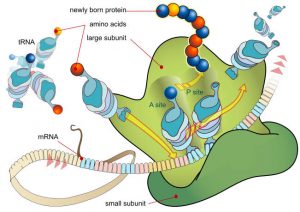What are Ribosomes? – Function, Structure, Synthesis
All cell organelles consist of Ribosomes, which play a very important role in the conversion of genetic code into amino acids, which in turn will help the growth and evolution of the species through generations. So here in the article below, we are going to provide a detailed description of the Ribosomes in cells, Ribosome’s structure and function, as well as different types of ribosomes.
What is a Ribosome?
The ribosome is an organelle cell, that is composed of protein and RNA, which helps in the conversion of genetic code into chains of amino acids. This process of defined as protein synthesis, and it is actively observed in all living cells, especially in both eukaryotic and prokaryotic cells.
Besides, it also plays an active role in decoding the nucleotide sequence, by binding itself to messenger ribonucleic acid (mRNA). After this, the transfer of ribonucleic acid(tRNA), enters the ribosome and results in the addition of amino acids to the protein chain of RNA.
Types of Ribosomes
Ribosomes are generally differentiated into two types, free and fixed, based on whether they are bound to the membrane of the cell.
Free Ribosomes
These types of ribosomes, as their name suggests, are not membrane-bound, and are generally found in Cytosol. Moreover, unlike fixed ribosomes, they have the ability to move freely throughout the cell. Furthermore, the free ribosomes help in the process of protein synthesis, by synthesizing all the available proteins in the said cell.
Fixed Ribosomes
The Fixed Ribosomes, unlike free ribosomes, are directly attached to the Rough Endoplasmic Reticulum (rER). The structure of the Fixed Ribosomes is quite similar to that of the structure of Fixed Ribosomes. Besides, the fixed ribosomes also actively take part in the process of protein synthesis at two different locations,
- They are inserted into the cell membrane and are moved through the plasma membrane.
- Besides, they are inserted into membrane-bound versicles and are moved through the Golgi complex.
And here in these two regions, the fixed ribosomes take part in the syncretization process of proteins.
Structure of Ribosomes

As you can observe from the above picture, the ribosomes include various components, each performing different functions. More importantly, the structure of Ribosomes comprises two components, a large and a small subunit. And as said above, the smaller subunit plays an active role in binding itself to the mRNA and decoding the genetic information, while the large subunit takes part in adding amino acids.
Besides, the ribosomes’ structure consists of 38% protein, while the remaining is comprised of RNA. Moreover, the ribosomes are partially scattered in two main regions inside the cytoplasm, where they perform protein synthesis.
Functions of Ribosomes
Now that you have a good understanding type of ribosomes in plant cells, and their structure, let us now find out the various functions of Ribosomes.
- Ribosomes play an active role in the transcription of DNA, by binding to mRNA.
- All the proteins synthesized within the cytoplasm, without the help of bound ribosomes will remain inside the cytoplasm.
- The tRNA components participate in protein synthesis.
- Besides, it helps in the assembling of amino acids to form proteins, that take part in cellular functions.
- Furthermore, the synthesis of mRNA occurs in the nucleus, then it is transferred to the cytoplasm, where the protein synthesis process occurs.
Conclusion
There are many important topics or chapters in this subject, which are quite hard to study for students to study or understand on their own. For these types of students, the Online Home Tutor classes offered by the Tutoroot platform might be a good choice. As they come with various amazing benefits including cost-effective prices, exclusive doubt clearing sessions, a customizable environment, expert staff guidance, and many more. Visit the official platform to learn more about these benefits and the Online Interactive Classes.
Frequently Asked Questions
What are the functions of Ribosomes?
The Ribosomes perform various functions, such as Protein Synthesis, DNA transcription, cellular functions, assembling amino acids, and many more.
Where are ribosomes found?
Ribosomes are located inside the cytoplasm of the cell.
Where are ribosomes made?
The nucleolus region found inside the nucleus of a cell is where the ribosomes are generally made.
